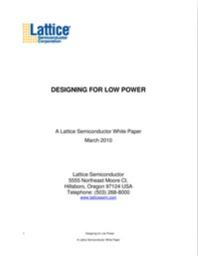DESIGNING FOR LOW POWER
Power consumption is becoming an increasingly important variable when it comes to calculating OPEX and carbon footprint for telecom infrastructure projects. For example, on average, each fully loaded 3G cell site costs approximately $1600/yr US or $3200/yr in Europe. In addition to these costs, the level of consumption per cell site leads to an estimated 11 tons of carbon dioxide emissions per cell site per year.
For these operators, power equals cost. FPGAs are becoming one of the most important facets of basestation architectures, and so the spotlight has fallen on them to minimize power consumption.
Download this whitepaper to learn more.
Read More
By submitting this form you agree to Lattice Semiconductor Corporation contacting you with marketing-related emails or by telephone. You may unsubscribe at any time. Lattice Semiconductor Corporation web sites and communications are subject to their Privacy Notice.
By requesting this resource you agree to our terms of use. All data is protected by our Privacy Notice. If you have any further questions please email dataprotection@techpublishhub.com
Related Categories: Components, Power, Switches

More resources from Lattice Semiconductor Corporation
Platform Management Using Low-Cost Non-Volatile PLDs
Power-up control, general purpose I/O expansion, voltage level translation and interface bridging are common functions in telecom infrastructure, s...
HDMI® Enhanced Audio Return Channel (eARC) Future Proofs Home Theater Connectivity with Uncompromised Audio Quality
HDMI Version 2.1 is the specification's most substantial upgrade. Video delivery speed increases 300%, and a compression feature can increase this ...
IMPLEMENTING PCI EXPRESS BRIDGING SOLUTIONS IN AN FPGA
Like its predecessor, the Peripheral Component Interconnect (PCI), PCI Express is becoming a ubiquitous system interface. Unlike PCI, PCI Express a...
